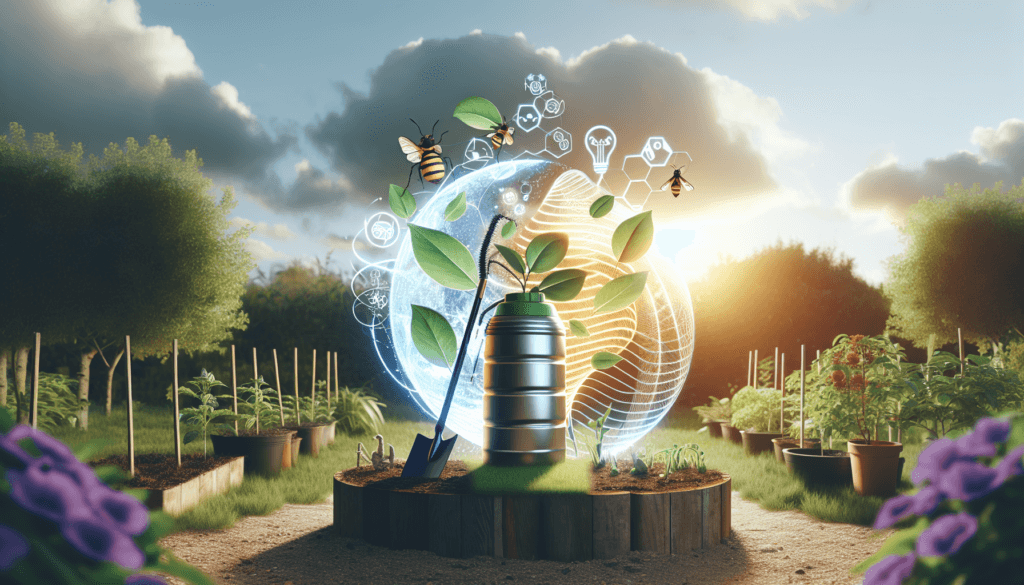If you’re someone who loves spending time tending to their garden, you already know how frustrating it can be when pests invade your beautiful green space. But worry not, because in this article, we will explore the best eco-friendly methods to control those unwelcome critters. From natural pest repellents to clever companion planting strategies, we’ve got you covered. So grab your gardening gloves and let’s get started on maintaining a pest-free garden!
Choosing Native Plant Varieties
Benefits of Native Plants
Planting native plant varieties in your garden comes with numerous benefits. Native plants have evolved and adapted to the local climate and soil conditions, making them hardy and resilient. They require less water, fertilizer, and pesticides than non-native plants, making them more environmentally friendly. Additionally, native plants attract and support local wildlife, such as birds, butterflies, and bees, by providing food and shelter. By choosing native plant varieties, you can help restore and preserve the natural ecosystem of your area.
Attracting Natural Predators
One of the advantages of including native plant varieties in your garden is their ability to attract natural predators. Native plants provide habitat and food sources for beneficial insects, such as ladybugs, lacewings, and parasitic wasps, which are natural enemies of many garden pests. These predators feed on harmful insects, helping to naturally control pest populations without the need for chemical interventions. By creating a welcoming environment for these natural allies, you can establish a balanced ecosystem that keeps pest populations in check.
Creating Healthy Ecosystems
Native plant varieties play a crucial role in creating and maintaining healthy ecosystems. Their deep roots help prevent soil erosion, improve soil quality, and enhance water infiltration. They also provide food and shelter for a diverse range of wildlife, including pollinators and other beneficial insects. By incorporating native plants in your garden, you contribute to the preservation and restoration of native habitats, while fostering biodiversity and encouraging the overall health of your local ecosystem.
Implementing Integrated Pest Management (IPM)
Understanding IPM
Integrated Pest Management (IPM) is a holistic approach to pest control that focuses on minimizing the impact of pests while protecting the environment and human health. It involves a combination of prevention, monitoring, and control strategies that aim to maintain pests at acceptable levels without solely relying on chemical pesticides. The key principles of IPM include regular monitoring of pest populations, setting action thresholds, and applying a range of eco-friendly pest control methods.
Identifying Garden Pests
To effectively manage garden pests, it is essential to accurately identify the types of pests present in your garden. Different pests require different control strategies, so correctly identifying them will help you choose the most appropriate methods. Regularly inspect your plants for signs of damage, such as chewed leaves, holes, or unusual spots. You can also use resources like field guides or consult local gardening experts to help you identify common pests in your area.
Monitoring Pest Levels
Regular monitoring of pest populations is an important aspect of successful IPM. By keeping a close eye on pest levels, you can detect any changes early on and intervene before infestations become severe. Monitoring can be done through visual inspections, the use of traps, or monitoring devices specifically designed for certain pests. By understanding the population dynamics of pests in your garden, you can determine the most appropriate timing for implementing pest control measures.
Setting Action Thresholds
Setting action thresholds is an integral part of IPM. Action thresholds define the pest population levels at which intervention is necessary to prevent damage to your plants. These thresholds are determined by factors such as the type of pest, the plant’s susceptibility, and the desired level of damage tolerance. By establishing action thresholds, you can avoid unnecessary or premature pest control measures and focus on intervening only when the pest population exceeds the predetermined threshold.
Applying Eco-Friendly Controls
In IPM, the use of eco-friendly pest control methods is prioritized. These methods include physical, biological, and cultural controls that aim to disrupt the pest’s life cycle, prevent infestations, or reduce pest populations without harming beneficial insects, wildlife, or the environment. Some examples of eco-friendly controls include using pheromone traps, introducing predator insects or beneficial nematodes, practicing crop rotation, and utilizing natural pesticides derived from plants, such as neem oil. By applying a combination of these methods, you can effectively manage pests while keeping your garden and the environment healthy.

Encouraging Beneficial Insects
Introduction to Beneficial Insects
Beneficial insects are an integral part of a natural pest control system. They prey on common garden pests, helping to keep their populations in check without the need for chemical pesticides. Beneficial insects include ladybugs, lacewings, parasitic wasps, and hoverflies, among others. These insects feed on pests like aphids, caterpillars, and mites, providing an eco-friendly and sustainable solution to pest management.
Attracting and Providing Habitat for Beneficial Insects
To encourage beneficial insects to visit your garden, it is important to provide them with the right conditions. Native plant varieties are particularly effective at attracting and supporting beneficial insects. By planting a diverse array of native flowers, herbs, and grasses, you can provide these insects with a food source and a habitat. Offering a variety of flowers that bloom at different times throughout the season ensures a steady food supply, encouraging beneficial insects to stay in your garden and help control pests.
Using Insectary Plants
Insectary plants are specific plants that are particularly attractive to beneficial insects. These plants provide nectar, pollen, and shelter, thus creating an ideal environment for the beneficial insects to thrive. Some popular insectary plants include yarrow, fennel, dill, and cilantro. Planting these alongside your other garden plants can help create an inviting habitat for beneficial insects, enhancing their presence and effectiveness in natural pest control.
Avoiding Harmful Insecticides
To successfully encourage beneficial insects, it is important to avoid using harmful insecticides that can inadvertently harm or kill them. Chemical insecticides not only kill pests but also eliminate beneficial insects, disrupting the natural balance in your garden. Instead, opt for eco-friendly alternatives such as neem oil or insecticidal soaps, which target specific pests while being safer for beneficial insects. By prioritizing the health and well-being of beneficial insects, you can create a more sustainable and effective pest control strategy.
Using Physical Barriers
Installing Row Covers
Row covers are a simple and effective physical barrier that can protect your plants from pests. These covers are made from lightweight fabric that is draped over your plants, creating a barrier between the plants and insects. Row covers prevent pests such as caterpillars or beetles from reaching your plants and laying their eggs, effectively reducing the risk of damage and infestation. Additionally, row covers can also protect your plants from extreme weather conditions, acting as a shield against frost or excessive heat.
Constructing Protective Netting
Protective netting is another practical option for creating a physical barrier against pests. This fine netting is typically made from nylon or polyethylene and can be draped over larger plants or entire garden beds. The netting creates a barrier that discourages pests like birds, rabbits, or deer from accessing your plants. It also prevents flying insects, such as moths or butterflies, from laying eggs on your crops. Protective netting allows for proper air circulation and sunlight while effectively safeguarding your plants.
Utilizing Fences and Barriers
Fences and barriers are particularly useful for protecting your garden from larger pests or animals. Installing a sturdy fence around your garden can deter animals like deer, rabbits, or groundhogs from entering and causing damage. Additionally, you can also construct barriers around specific plants or beds using materials like wire cages or plant collars. These barriers prevent pests, including squirrels or larger insects, from reaching your plants and causing harm.

Utilizing Companion Plants
Companion Planting Basics
Companion planting involves strategically planting certain plants together to enhance their growth and deter pests. By selecting plant combinations that work synergistically, you can achieve improved pest control and productivity in your garden. Some companion planting principles include planting aromatic herbs to repel pests, intercropping with plants that attract beneficial insects, and using tall plants to provide shade or wind protection for smaller, more delicate plants.
Plants with Pest-Repelling Properties
Certain plants have natural properties that repel specific pests, making them excellent companions for other vulnerable plants. For example, marigolds are known for their ability to repel nematodes, aphids, and other pests. Planting marigolds alongside vegetables like tomatoes or cucumbers can help protect them from these common garden pests. Similarly, herbs like basil, rosemary, and mint have strong scents that naturally deter pests like aphids or flies.
Creating Diverse Plant Communities
Diversity in your garden is key to effective companion planting and pest control. By planting a variety of different plants, you create a complex and diverse ecosystem that is less susceptible to pest outbreaks. The diversity of plants attracts a wider range of beneficial insects, which in turn helps to control pests naturally. Additionally, planting diverse crops and rotating them annually reduces the risk of pests becoming established and spreading throughout the garden. By creating a harmonious and diverse plant community, you can promote a healthy and balanced ecosystem in your garden.
Practicing Crop Rotation
Understanding Crop Rotation
Crop rotation involves systematically changing the types of crops planted in a specific area over multiple growing seasons. This practice helps disrupt pest life cycles and reduce the buildup of pests and diseases in the soil. Different crops have varying vulnerabilities to specific pests, so rotating crops limits the availability of hosts and disrupts pest populations, making it harder for pests to establish themselves.
Benefits of Crop Rotation for Pest Control
By implementing a crop rotation plan, you can effectively decrease pest populations and minimize the need for chemical interventions. Crop rotation breaks the life cycle of pests, interrupting their ability to reproduce and infest your plants. Additionally, rotating crops helps prevent the buildup of pests that specifically target certain crops, as pests struggle to adapt and find new hosts. This natural pest control method is not only eco-friendly but also improves soil health and fertility.
Implementing a Crop Rotation Plan
To implement a crop rotation plan, start by categorizing the plants you want to grow into different groups based on their families or types. Then create a rotation schedule, ensuring that plants from the same family or type are not grown in the same location in consecutive years. It is important to consider the specific pest vulnerabilities of different crops and design a rotation plan that suits your garden’s needs. Incorporating green manure cover crops, such as legumes or brassicas, during fallow periods can further enhance soil health and pest control.

Organic Pest Control Sprays
Homemade Insecticidal Soaps
Homemade insecticidal soaps are an effective and eco-friendly way to control pests in your garden. These soaps are made from natural ingredients such as liquid castile soap, vegetable oil, and water. They work by suffocating or dehydrating pests like aphids, mealybugs, or mites upon contact. To make a homemade insecticidal soap, mix one tablespoon of liquid soap and one quart of water in a spray bottle. Apply the solution directly to the affected plants, ensuring thorough coverage, and repeat as necessary.
Neem Oil as a Natural Pesticide
Neem oil, derived from the neem tree, is an organic pesticide that acts as a repellent, insecticide, and fungicide. It targets a wide range of pests, including aphids, whiteflies, and caterpillars, while being safe for beneficial insects. Neem oil disrupts insect feeding and reproduction, ultimately leading to reduced pest populations. To use neem oil, dilute it with water according to the instructions on the package and spray it onto the affected plants. Apply neem oil in the early morning or late evening to avoid leaf burn and ensure efficacy.
Garlic and Pepper Sprays
Garlic and pepper sprays are natural deterrents that can help control a variety of pests in your garden. These sprays work by emitting strong odors or tastes that repel pests and disrupt their feeding and mating behaviors. To make a garlic spray, blend a few cloves of garlic with water, strain the mixture, and add a small amount of liquid soap. For a pepper spray, blend hot chili peppers with water, strain, and add a small amount of liquid soap. Spray the mixture directly on affected plants and reapply after rainfall or as needed.
Using Biological Control Methods
Introduction to Biological Control
Biological control is the practice of using living organisms to control pests. This method involves introducing specific natural enemies, such as predatory insects or beneficial nematodes, to target and eliminate pests. Biological control can be an effective, eco-friendly, and sustainable alternative to chemical pesticides, as it harnesses the natural mechanisms of pest control already present in ecosystems.
Utilizing Predatory Insects
Predatory insects can be valuable allies in controlling pests. Ladybugs, lacewings, and predatory beetles, for example, feed on aphids, mites, and other common garden pests. To attract these insects, you can provide them with suitable habitats, such as by planting native grasses, leaving undisturbed areas for nesting, and providing water sources. Additionally, you can purchase predatory insects from reputable suppliers and release them strategically in your garden, ensuring they have a reliable food source.
Deploying Beneficial Nematodes
Beneficial nematodes are microscopic, worm-like organisms that can effectively control soil-dwelling pests. They prey on grubs, caterpillars, and other larvae that live in the soil, reducing their populations and preventing plant damage. To deploy beneficial nematodes, dilute them in water according to the instructions and apply the solution to the soil around affected plants. Beneficial nematodes work best when the soil is moist, so watering before application is recommended. By utilizing these natural predators, you can improve pest control while avoiding harmful chemical pesticides.

Implementing Cultural Practices
Proper Watering and Irrigation
Proper watering and irrigation practices are essential for maintaining plant health and preventing pest problems. Consistent and deep watering encourages root growth, making plants more resilient to pests and diseases. Avoid overwatering, as overly wet conditions can attract pests like slugs or snails. When watering, direct water to the base of plants rather than overhead to minimize fungal diseases. Additionally, practicing drip irrigation or using soaker hoses reduces the chances of wet foliage, promoting healthier plants and reducing pest risks.
Regular Weeding and Garden Cleanup
Regular weeding and garden cleanup play a crucial role in pest prevention. Weeds can provide habitats for pests, serve as alternate hosts for diseases, and compete with desirable plants for resources. By regularly removing weeds, you eliminate potential pest breeding grounds and reduce the risk of infestations. Garden cleanup involves removing dead plant debris, fallen fruits, and diseased plant parts, as these can harbor pests and diseases. Raking and disposing of these materials properly helps maintain a clean and pest-free garden environment.
Maintaining Healthy Soil
Maintaining healthy soil is a fundamental cultural practice for effective pest control. Healthy soil supports vigorous plant growth, increases plant resilience to pests and diseases, and encourages beneficial soil organisms. To promote healthy soil, incorporate organic matter, such as compost or well-rotted manure, to improve soil structure and nutrient content. Proper soil pH levels and adequate fertility are also important for optimal plant growth. By providing a nutrient-rich environment for your plants, you create conditions that discourage pests and promote a vibrant garden ecosystem.
Mulching to Suppress Pests
Mulching is a beneficial practice that can help suppress weeds and control pests in your garden. Organic mulches, such as straw, wood chips, or shredded leaves, create a physical barrier that prevents weed growth and discourages pests from reaching your plants. Mulches also conserve soil moisture, regulate soil temperature, and improve soil structure, further contributing to plant health and resilience. Apply a layer of mulch around your plants, leaving a small gap around the plant stem to prevent moisture and pest trapping.
Avoiding Chemical Pesticides
Negative Effects of Chemical Pesticides
Chemical pesticides can have detrimental effects on the environment, human health, and beneficial organisms. These toxic substances can contaminate soil, water, and air, leading to harmful consequences for ecosystems and wildlife. Additionally, chemical pesticides can accumulate in our food chain, posing risks to human health. Overreliance on chemical pesticides can also lead to the development of pesticide-resistant pests, making control more challenging in the long run. By avoiding chemical pesticides and opting for eco-friendly alternatives, you can protect your garden’s ecosystem and contribute to a healthier environment.
Safe Alternatives to Chemical Pesticides
Fortunately, there are numerous safe and effective alternatives to chemical pesticides available for garden pest control. Integrated Pest Management (IPM) techniques, planting native varieties, employing physical barriers, and utilizing biological control methods are all eco-friendly options that can effectively manage pests while minimizing harm to the environment. Additionally, cultural practices like proper watering, weeding, and maintaining healthy soil contribute to plant resilience and natural pest control. By adopting these alternative methods and strategies, you can successfully control pests in your garden while promoting a sustainable and environmentally friendly approach.
In conclusion, choosing native plant varieties, implementing integrated pest management techniques, encouraging beneficial insects, using physical barriers, utilizing companion plants, practicing crop rotation, employing organic pest control sprays, using biological control methods, implementing cultural practices, and avoiding chemical pesticides are all effective ways to control pests in your garden while prioritizing environmental sustainability. By adopting these eco-friendly practices, you can create a thriving and resilient garden ecosystem while minimizing the use of harmful chemicals and protecting the long-term health of your garden and the surrounding environment.



